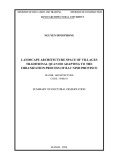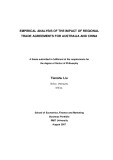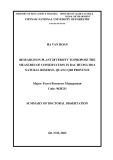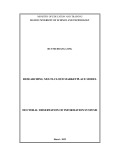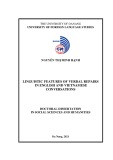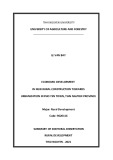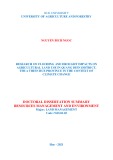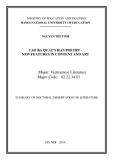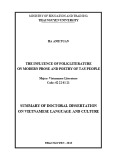1 2 4. Research Methods INTRODUCTION Data collection methods: Data sources for dissertation research include secondary and primary data 1. Necessity of research sources International economic integration is an indispensable trend in the world today. n the process of Data analysis method: Primary data were surveyed by the author for 6 months from October 2017 to international economic integration, Vietnamese enterprises in general and especially Vietnam Post and April 2018 through a questionnaire, then use quantitative research methods to run data on SPSS25.0 software Telecommunications enterprises in particular are facing a great challenge of what to do to maintain and to quantify the relationship between the elements that constitute the leadership capacity of the middle leader develop their operations in order to survive and thrive in an increasingly competitive business environment. team at 3 Posts and Telecommunications enterprises with the results of their own leadership. Especially in the context of the constantly changing world economy, the trend of deeper and deeper international economic integration, the increasingly fierce and fierce global business and competition 5. New contributions of the thesis environment, have been setting forth Great requirements and challenges for Vietnamese enterprises and 6. The structure of the thesis business leaders. In particular, the requirement to build a modern leadership team with full qualifications, In addition to the introduction and conclusions, the thesis is structured into 5 chapters: knowledge and leadership is a very urgent requirement for Vietnamese enterprises today. Post and Chapter 1: Overview of research Telecommunication sector is a spearhead economic sector of Vietnam, businesses operating in the field of Chapter 2: Theoretical foundations Posts and Telecommunications are always considered as effective activities contributing to the growth of the Chapter 3: Research Methods national economy. But in the context of today's global competition, not all businesses are successful. Up to Chapter 4: Reseach Results the present time, the Post and Telecommunications industry in Vietnam has 11 enterprises operating in which are Chapter 5: Findings and Recommendations typically 3 enterprises: Vietnam Posts and Telecommunications Group (VNPT), Vietnam Post Corporation (VNPost) and Military Telecom Corporation (iettel) with a total of 774 middle leaders with an average age of 40 CHAPTER 1. OVERVIEW OF RESEARCH years and seniority of more than 10 years. In recent years, with the adherence to the standards in the regulations on 1.1. Overview of the researches on leadership capacity of the enterprise management team appointment of leaders at all levels, it has basically met the requirements of enterprises and the Post and Telecommunications industry. However, up to now, most enterprises in the Post and Telecommunications Regarding the research contents of the thesis, the author has studied the research related to leadership industry have not developed a title standard for middle and low leaders, but have only built a common title capacity such as: JeffreyA. Barach and D. Reed Eckhardt (1996); Mohamed (2007); Rod L. Lanigan (2012); standard for senior leaders (CEO). Therefore, the middle leaders of Post and Telecommunications enterprises in Taylor, Cornelius and Kate Colvin (2014); Luu Ngoc Hoat (2015); Truong Hong Vo Tuan Kiet and Lam general is still familiar with subsidy management practices, not really breaking through and integrating with the Huon (2015); Tran Thi Van Hoa (2011); Nguyen Manh Hung (2012); Tran Thi Phuong Hien (2014); Le market mechanism. Therefore, the current problem is the leadership capacity of the middle leaders of Vietnam Quan (2011); Dang Ngoc Su (2012) ... Post and Telecommunications enterprises to what extent and how much can meet the needs of the global process 1.2. Overview of the researches on the components of enterprise leadership capacity From the overview of theories of leadership capacity above, it can be seen that: leadership qualities, internationalization and integration. For the above reasons, the author has chosen the topic "Research on middle leadership capacity at the Post and Telecommunication Enterprises in Vietnam" for my thesis. 2. Research purpose leadership knowledge and leadership actions are necessary for any leadership position and there are three components of leadership capacity are: Stogdill (1948, 1974); Sankar (2003); Smith and Foti (1998); Jeffrey Assessing the status of the leadership capacity of the middle leader team at Posts and Telecommunications D. Horey and Jon J. Facesen (2003); Bass (1996,1997); W.Bennis (1989, 2009); Tran Thi Phuong Hien enterprises in Vietnam, based on which propose feasible solutions to develop and further enhance the (2014)... capacity of middle leader team at Posts and Telecommunications enterprises in Vietnam. 1.3. Overview of the researches on enterprise leadership results 3. Object and scope of research Measurement of leadership results is recorded from different perspectives, serving different research 3.1. Object of research: the middle leader team at Posts and Telecommunications enterprises in Vietnam. purposes, in which people often approach leadership results in two groups of criteria: group of financial and 3.2. Scope of research non-financial indicators: Koene, Vogelaar and Soeters (2002); Knippenberg D.V, Hogg M.A. (2003); Piero et al (2005) .... About space: Currently in Vietnam there are 11 enterprises operating in the field of post and telecommunications. In the framework of the thesis, the case study author at 3 enterprises: Vietnam Post and 1.4. Overview of the researches on the relationship between the components of leadership capacity and Telecommunications Group (VNPT), Vietnam Post Corporation (VNPost) and Military Telecom enterprise leadership results Corporation (Viettel). Reave (2005); Mumford et al (2000); Noel Balliett Thun (2009); Sarah E. Strang và Karl W. Kuhnert About time: Secondary data was collected in the years 2014-2017, primary data was collected from (2009); Jon Aarum Andersen (2006); Luong Thu Ha (2015)… October 10, 2017 to April 2018, and the proposed solution was to 2025.
3 4 1.5. Research gaps Chairman, ...) and the staff. They are an important link between the strategic vision of senior leaders and those who directly implement. They are the people who communicate, plan, manage and turn the ideas of The author directs my research on the impact of middle leadership components on enterprise senior leaders into reality. 2.2.2. The role of middle leaders
T leadership results at Posts and Telecommunications enterprises in Vietnam to study part of the gap in the studies before.
CHAPTER 2. THEORETICAL FOUNDATIONS 2.2.3. The concept of middle leadership capacity 2.1. Theoretical foundations of leadership and leadership capacity Middle leadership capacity in the thesis is understood as a combination of leadership knowledge, leadership qualities and leadership actions that a middle leader should have in leadership activities, team leadership 2.1.1. Theoretical foundations of leadership subordinates to achieve the goals of the enterprise set from the beginning. 2.1.1.1. The concept of leadership 2.2.4. Framework of middle leadership capacity True scientific research on leadership has only begun in the twentieth century, although leadership has long 2.3. Elements of middle leadership capacity in the enterprise been a subject of concern to philosophers and historians. Scholars and researchers around the world have given various definitions to the term "leadership" and these definitions also change over time. This concept 2.3.1. Leadership qualities (BE) can be approached in terms of substance, behavior perspective, can also be approached in terms of influence or interaction interaction. We consider and research some outstanding views of researchers such as Stogdill a. Positive qualities: Far-sighted vision; Adventurous and assertive; Inquisitive; Innovative and creative thinking; Flexible and responsive; Responsibility; Comprehensiveness; Professional ethics; Patience (1950); Merton (1957); Hemphill & Coons (1957); Bennis (1959); Janda (1960); Tannenbaum, Weschlert & Confidence; Empathy; Inspire… Masarik (1961); Fiedlert (1967); Jacobst (1970); Katzt & Kahnt (1978); Hollandert (1978); Burns (1978); Hart (1980); Herseyt & Blanchardt (1982); Rauch & Behling (1984); Jacobst & Jaques (1990); Campbell b. Negative qualities: Egotistic; Arrogant; Thought to dominate; Crafty tricks … (1991); Drath & Palus (1994); Clark (1997); Mumford (2000); Yukl (2002); Warren Bennis (2009)… 2.3.2. Leadership knowledge (KNOW) 2.1.1.2. Differentiating between "Leadership" and "Management" - The general business knowledge includes: knowledge about businesses and industries, business areas of 2.1.1.3. Differentiating between "Leadership" and "Administration" enterprises, knowledge about culture and society,… 2.1.1.4. The theory of leadership - Knowledge of leadership includes: knowledge of personal leadership, knowledge of business strategy, According to Bolden et al. (2003), the summary of leadership theory includes the following outstanding knowledge to run business operations, knowledge of human resource management. schools: The leader individuality theory; Behavioral leadership theory; Theory of situational leadership; The theory of random leadership; Leading theory leads to goals; Professional leadership theory; New leadership - Other additional knowledge is also needed for middle leadership such as knowledge of corporate culture, theory on quality. knowledge of change management, international economic integration, and foreign language and information technology. 2.1.2. Theoretical foundations of leadership capacity 2.1.2.1. The concept of capacity 2.3.3. Leadership action (DO): Accept the challenge; Create shared vision; Staff development; Set an example for subordinates; Transfusion enthusiasm. The term individual competencies used in research are "a combination of qualities, knowledge and the ability to manipulate them (actions) to perform well the work of the individual". 2.4. Factors affecting middle leadership capacity in the enterprise 2.1.2.2. Concept of leadership capacity 2.4.1. Factors that belong to the leader himself: Educational level; Experience; Natural qualities; Age; Based on the BKD (Be - Know - Do) model of Donald J. Campbell & Gregory J. Dardis (2004), the Family traditions; Health… author introduces the concept "Leadership capacity is a combination of knowledge, qualities and practices 2.4.2. Internal factors: The size of the business; Type of business; Organizational structure of the activities that a leader should have in leadership activities, leadership of subordinates, organizational enterprise… leadership to achieve the set goals of the enterprise”. 2.4.3. External factors: Economic environment; Political and legal environment; Cultural and social 2.2. Theoretical foundations of middle leadership capacity in enterprises environment; Science and technology environment; The level of competition in the market. 2.2.1. The concept of middle leadership 2.5. Enterprise leadership results Middle leadership is the intermediary between the senior management (General Director, Director, 2.5.1. Concept of the results of enterprise leadership
5 6 The results of enterprise leadership are understood as the result of the leadership's impact on employees Step 4: Preliminary quantitative research to assess scales with small sample sizes. directly under and on the working environment in the enterprise. Step 5: Complete the scale before conducting the official survey. 2.5.2. The indicators measure the results of enterprise leadership Step 6: Test the model by Pearson correlation coefficient analysis, multivariate regression analysis. 2.5.2.1. Financial indicators: sales, profits, business growth, stock market price …. Step 7: Presenting a discussion of the research implications of three hypotheses, thereby proposing tasks that 2.5.2.2. Non-financial indicators: Staff satisfied at work; Employees are committed to sticking with the middle managers need to perform in their unit management. business; Staff feel comfortable mentally; Ability to organize work; Thought to be innovative. 3.2. Data sources 2.6. Research models 3.2.1. Primary data 2.6.1. Choice of fundamental theory Primary data was collected from surveys through questionnaires of three typical Post and Because of the research topic on the components of leadership capacity, the author decided to "localize" my Telecommunications enterprises in Vietnam (Vnpost, Viettel, VNPT). research in the theoretical framework of leadership capacity under the model of BKD (Be-Know-Do) of 3.2.2. Secondary data Donald J Campbell & Gregory J. Dardis (2004). Secondary data is collected from documents of the General Statistics Office, Ministry of Information and 2.6.2. Research models Communications, Ministry of Defense and from the three typical Post and Telecommunications enterprises in Vietnam (Vnpost, Vietel, VNPT). 3.3. Research Methods 3.3.1. Qualitative research
MIDDLE LEADERSHIP CAPACITY
Leadership qualities (BE)
Leadershipknowledge(Know)
Leadership action (DO)
3.3.1.1. Expert method: The expert method is used by the author to further clarify the research contents, LEADERSHIP especially the opinions of experts who help the author in designing the questionnaire and proposing solutions. RESULTS 3.3.1.2. In-depth interview method: The objective of the in-depth interview method is to adjust the draft scale designed from the results of the above-mentioned expert method to complete the official scale used in quantitative research. 3.3.2. Quantitative research
Variable control:
Age, gender, education, experience.
3.3.2.1. Preliminary quantitative research Step 1: Designing the official survey form Step 2: Choose a sample to investigate Figure 2.2. Research model of the thesis Step 3: Preliminary assessment of the scale Source: Author's proposal 3.3.2.2. Official quantitative research CHAPTER 3. RESEARCH METHODS The process of formal quantitative research in this research was conducted by the author through regression analysis of the influence of the three components of leadership capacity on the leadership results of the 3.1. Research process middle leadership team at 3 Post and Telecommunication enterprises in Vietnam(Viettel, Vnposst, VNPT). Step 1: Confirm research objectives. CHAPTER 4. RESEARCH RESULTS Step 2: Building a theoretical framework of leadership designed according to BKD model of Donald J. 4.1. Research results on the status of middle leadership capacity at Post and Telecommunications Campbell & Gregory J. Dardis (2004) including 3 elements of leadership capacity (Be - Leadership qualities, enterprises in Vietnam Know- Leadership Knowledge and Do - Action leadership). 4.1.1. Overview of middle leadership team at Posts and Telecommunications Enterprises in Vietnam Step 3: Construction and calibration of scales.
7 8 4.1.1.1. About the age of the middle leadership team evaluation. The analysis process results are presented in detail in the next section. 4.1.1.2. About the gender of the middle leadership team 4.2.3. Results of assessing the reliability of the scale 4.1.1.3. About the education level of the middle leadership team The analytical results shown in Table 4.11 show that Cronbach's Alpha coefficients for all variables are greater than 0.7. This shows that the survey data is completely reliable. The correlation coefficient of the 4.1.1.4. About the qualification of the middle leadership team sum of all observed variables with the factor that these variables represent is greater than 0.5. This shows 4.1.1.5. About seniority of working and management experience that the respondents have the concept of the factor group given according to the observed variables 4.1.2. Research results on the status of middle leadership capacity at Post and Telecommunications expressing that factor, so the scale is built based on the appropriate observed variables. Therefore, the scales enterprises in Vietnam were concluded to ensure reliability. Observed variables and factors are retained for further analysis. 4.1.2.1. About the Leadership qualities (Be) 4.2.4. Results of the Exploratory Factor Analysis (EFA) The survey results shown in Table 4.6 show that all leadership qualities including positive and negative 4.2.4.1. Exploratory Factor Analysis (EFA) for the scale of independent variables qualities are assessed at average and fairly from 3.10 points to 3.49 points. In which, most leadership - Bartlett's test results show that the variables in the population are correlated with each other (Sig = qualities assessed by other subjects tend to be higher than middle self-assessment leaders. 0.000 <0.05), and the KMO coefficient = 0.926 > 0.5 demonstrates the factor analysis results to group 4.1.2.2. About the Leadership knowledge (Know) the variables together each other is guaranteed reliability. The information gathered in Table 4.7 shows that: Most of the leadership knowledge of the middle - The above observed variables have factor load factor (Factor Loading) > 0.5, which is up to the standard, leadership team is rated at less than 3.5 points on a scale of 5. Assessment of the status of the knowledge also and the difference between the factor load factors of the observed variables is greater than 0.3. Therefore, has some points is the heterogeneity between middle leaders and others; Middle leaders tend to there is no need to eliminate any observed variables in the analysis. underestimate other subjects. - Eigenvalues coefficient of the third factor is 4.388> 1, proving that the data obtained has a good 4.1.2.3. About the Leadership action (Do) convergence, confirming that there are 03 factors drawn from the analysis. The information gathered in Table 4.8 shows that: Most of the leadership actions of the middle leadership - The coefficient of total variance extracted of 03 factors is equal to 57,464, showing the variation of factors team are assessed to be quite high, on average 3.5 points on a five-point scale. Leadership qualities and given in the analysis can explain 57.46% of the variability of the original survey data. The value of extracted leadership knowledge, when evaluating leadership actions also have heterogeneity between middle leaders variance is greater than 50%, so that an analysis is required. and other subjects, middle leaders often tend to underestimate another statue. 4.2.4.2. Exploratory Factor Analysis (EFA) for the scale of dependent variable 4.1.3. General assessment of middle leadership team and middle leadership capacity at Posts and The analytical results shown in Table 4.13 also show that the factor analysis for the dependent variable also Telecommunications enterprises in Vietnam ensures reliability when the KMO coefficient = 0.882> 0.5, the variance extracted by 56.784 shows the 4.1.3.1. General assessment of middle leadership team variation of The observed variables in this group will represent 56.78% of the variation of the factor. 4.1.3.2. General assessment of middle leadership capacity 4.2.5. Results of multiple linear regression analysis 4.2. The results of the study on the influence of the components of middle leadership on leadership Table 4.14. Summary of regression models results at Posts and Telecommunications enterprises in Vietnam R R2 Models R2 adjustment Durbin- Watson 4.2.1. Results of survey screening The author investigated 986 people and collected 831 questionnaires then filtered out 751 valid .900a 0.780 0.774 1.664 questionnaires. The model of middle leadership team self- assessment 4.2.2. Results of sample analysis .872a 0.760 0.758 1.835 Models of other subjects assessed Data collected from this 751 votes will be used to conduct analysis, to answer the research questions posed. After performing the data cleaning and processing of primary data through Excel software, the final data is Source: Data analysis results entered into SPSS 25.0 software data so that software tools can be started to be distributed and conduct
LEADER SHIP QUALITIES
9 10 The regression analysis results shown in Table 4.16 show that: The coefficient Sig = 0.000 in the industry and the change of the operating environment of the enterprise.… ANOVA test shows that the reliability in the regression analysis results is guaranteed with low errors; This Thirdly, in addition to the awareness of the importance of learning and training leadership qualities, the confirms that the independent variables all affect the dependent variable, which also means that the medium leadership team at Post and Telecommunications enterprises in Vietnam also need to know how to constituent elements of the middle leadership will affect the leadership results. Moreover, the VIF coefficient apply them sensible on your business leadership action. of all factors is less than 2.0, so there is no multi-collinear phenomenon between independent variables. Both 5.2.2. Improve leadership knowledge (KNOW) regression models with adjusted Beta coefficients are greater than zero, showing a positive correlation between the independent and dependent variables. With the above results, the regression equation was Firstly, participating in training courses for middle leaders organized by domestic and foreign units with investigated for the two models as follows: topics related to the basic knowledge that a middle leaders must have and new leadership knowledge consistent with the characteristics of the Post and Telecommunications industry integrated from other KQ = 0.524* TC + 0.516* HD + 0.385* KT (1) countries in the world such as: knowledge of human resource management, financial management, personal KQ = 0.538* HD + 0.490* TC + 0.434* KT (2) leadership, knowledge on planning and building a business strategy… In which: (1) is the evaluation model of middle leadership team, (2) is the evaluation model of other Secondly, regularly update and supplement new leadership knowledge through the mass media, via the groups (including senior leaders, low leaders and junior staff). internet, through magazines and newspapers related to leadership activities such as: business magazines, Saigon businessman newspaper, knowledge magazine today… 4.2.6. Results of testing the differences between control variables when evaluating leadership results Thirdly, participate in business forums, clubs or seminars to share leadership and management experiences 4.2.6.1. Differences between sex groups in order to collect information and improve the leadership vision for themselves such as business clubs, 4.2.6.2. Differences between age groups forums business director, middle business forum, staff day seminar or Post and Telecommunications 4.2.6.3. Differences between education groups industry… 4.2.6.4. Differences between experience groups 5.2.3. Improve leadership action (DO) 4.2.7. Test results of research hypotheses - For action of Accepting the challenge… With the above analysis results, the initial research hypotheses have been proved to be statistically - For action on Staff Development… significant and accepted. - For action of setting an example for subordinates… CHAPTER 5. FINDINGS AND RECOMMENDATIONS 5.2.4. Developing "Leadership Capacity Framework" and "Career Map" for the middle leadership team 5.1. Discuss the research results at Posts and Telecommunications industry in Vietnam Research results have shown that all three components of the middle leadership team are leadership qualities, Table 5.1. Suggestions for “Leadership Capacity Framework” of the middle leadership team at Posts leadership knowledge and leadership actions that positively impact leadership results at Post and and Telecommunications industry in Vietnam Telecommunication enterprises in Vietnam. Therefore, the conclusion of the thesis can be drawn as "When the middle leadership team has the ability to respond to leadership capacity as much as possible, the results Name of capacity Description of capacity of business leadership will be better". creative ideas of Supporting employees 5.2. Recommendations Innovation and Creativity 5.2.1. Improve leadership qualities (BE) Seeing obstacles as opportunities for creative change Firstly, middle leadership team at Post and Telecommunications enterprises in Vietnam themselves must always be aware of the importance of learning and training to form appropriate personal qualities for your Sensitivingto business opportunities in the market leadership. Flexible and Responsive Secondly, during their operation, middle leadership team at Posts and Telecommunications enterprises in Knowing how to change the issued decision to suit the actual situation of the business Vietnam must find the missing and weak personal qualities to improve the personal nature; On the other hand, new characteristics must be formed to suit the characteristics of the Post and Telecommunications Responsibility High responsibility in work
11 12 new new from products, technologies, new markets. Daring to be responsible for your own actions, words and failures consistent with your for opportunities and Being decisions Looking challenges to test your abilities Assertiveness to make decisions Proactively to overcome difficulties Daring in emergency and complex situations
Praising employees for achievements Sensitiving to business opportunities in the market Visionary LEADER SHIP ACTION Building the organizational culture Know how to look far and wide Enthusiastic action for employees Ability to cover all jobs Comprehension Composing the song of Posts and Telecommunications Ability to assess the work situation Building the team spirit in a Fostering for employees Interested, motivated staff timely manner Empathetic Listening to the sharing of employees Braving to decentralize and delegate rights according to each employee's forte Empathy with the plight of the staff Staff development Encouraging employees to make their own decisions Knowledge of personnel management the Listening and caring about opinions of your employees Knowledge of laws related to Post and Telecommunications its Clearly and fully aware of management functions and duties Knowledge of foreign languages and basic information technology Set an example for subordinates Providing a process for achieving clear goals Knowledge of corporate culture Business leadership Compling with commitments and keep promises decentralization, of Knowledge authorization and work assignment the enthusiasm and Spreading goodwill at work for employees Knowledge of self-leadership LEADER SHIP KNOWL EDGE Create shared vision Encouraging people to share bright future wishes Knowledge of risk management and change management Imagining the future prospects
Source: Author's proposal Knowledge of business planning and strategy building Table 5.2. Suggestions for “Career Map” of the middle leadership team at the Post and Telecommunications industry in Vietnam Professional knowledge Full name: Professional knowledge about Post and Telecommunications such as: multimedia technology, information technology, multimedia communications, information security, electronic techniques ... Position: to cope with difficult Department is working: Daring challenges Accept the challenge Looking for business opportunities
2 .
3 .
1 .
2 .
1 .
3 .
5 . 3 .
i
l o o k i n g
L m
L e
q u a l i t i e s (
W
V i e t n a m " ,
… … … …
F o r f a m
.
T h ứ
w
N o . 1 1 ,
y e a r s
L e V a n
V a n
B e ) ,
… … … … … …
… … … … … …
i l i e s :
.
.
f o r w a r d
b a ,
t h e n e x t 5 - 1 0
e v i d e n c e a t
F o r b u s i n e s s e s :
E x p e c t a t i o n s o v e r
F o r t h e c o u n t r y :
t o
t h e
T h u a n
B u s i n e s s i s w o r k i n g :
s o m e f o l l o w i n g r e s u l t s :
2 .
3 .
1 .
H o w e v e r , d u r i n g
I n d u s t r y a n d T r a d e ,
P o s t s a n d
t h e s i s
e x p e r i e n c e f o r f u t u r e s t u d i e s .
t h e
S i t u a t i o n a n d s o l u t i o n s " ,
c o m m e n t s
a l s o
N o . 1 1 ,
k n o w l e d g e :
T h u a n ( 2 0 1 8 ) , " T h e i
L e a d e r s h i p
a n d
… … … … … …
l e a d e r
L e a d e r s h i p K n o w l e d g e (
D o n g P u b l i s h i n g H o u s e i n 2 0 1 8 .
( 2 0 1 8 ) , " A c c e s s
… … … … … … …
… … … … … … …
A u g u s t 2 0 1 8 , p p . 2 5 3 - 2 6 0 .
.
b u s i n e s s e s a c c e s s t o c r e d i t t h r o u g h i
T h e c o m p e t e n c i e s
L e a d e r s h i p a c t i o n s :
r e q u i r e d o f a m i d d l e
K n o w
l e a d e r s h i p k n o w l e d g e a n d l e a d e r s h i p a c t i o n s .
q u a n t i f i e d
L e a d e r s h i p q u a l i t i e s :
P r o c e e d i n g s o f
r e s e a r c h p r o c e s s ,
c o r r e c t i o n s
l e a d e r s h i p c a p a c i t y o f t h e m i d d l e l e a d e r s h i p t e a m
t h e
m p o r t a n c e o f
F i r s t l y , t h e t h e s i s c l a r i f i e s t h e c o n c e p t o f
3 .
t h e
s o
1 3
t h a t
i t h i n t h e f r a m e w o r k o f t h e s i s i n E c o n o m i c s o f
i n f l u e n c e
A u g u s t 2 0 1 8 , p p . 3 0 4 - 3 0 7 .
k n o w l e d g e :
m p r o v i n g f i n a n c i a l
2 . L e a d e r s h i p
1 . L e a d e r s h i p
t h e
C O N C L U S I O N
… … … … … …
o f
l e a d e r s h i p r e s u l t s i n 3 P o s t a n d T e l e c o m m u n i c a t i o n s e n t e r p r i s e s (
r e q u i r e d
… … … … … … …
… … … … … … …
i t a t i o n s o f r e s e a r c h a n d s u b s e q u e n t r e s e a r c h d i r e c t i o n s
.
t h e
b u i l d i n g p l a n i s
t o b a n k c r e d i t o f s m a l l a n d
m i d d l e l e a d e r s h i p
a u t h o r
) a n d L e a d e r s h i p A c t i o n (
L e a d e r s h i p a c t i o n s :
V N P T
w
,
T h e l e a d e r s h i p c a p a c i t y
q u a l i t i e s :
c a n
D o ) .
L I S T O F W O R K S B Y A U T H O R P U B L I S H E D
V N P o s t ,
c o m p o n e n t s
c o n t i n u e
o f
t o
i
V i e t t e l ) .
m i d d l e
t h e s i s a l s o c a n n o t a v o i d s h o r t c o m i n g s .
m e d i u m - s i z e d e n t e r p r i s e s
t h e n a t i o n a l s c i e n t i f i c c o n f e r e n c e " S u p p o r t i n g
i n t h e s e 3 e n t e r p r i s e s i n t h e f o l l o w i n g a s p e c t s :
m p r o v e
L e V a n T h u a n ( 2 0 1 8 ) , " E l e m e n t s o f t h e m i d d l e l e a d e r s h i p c a p a c i t y a f f e c t l e a d e r s h i p r e s u l t s :
i n
T e l e c o m m u n i c a t i o n s e n t e r p r i s e s i n V i e t n a m " , J o u r n a l o f I n d u s t r y a n d
a n d
m a n a g e m e n t c a p a c i t y a n d t r a n s p a r e n c y " ,
l e a d e r s h i p
T h e a u t h o r
V i e t n a m
d r a w
E m p i r i c a l
B u s i n e s s A d m i n i s t r a t i o n , t h e t h e s i s h a s a c h i e v e d
L e a d e r s h i p
i t h t h e t o p i c " R e s e a r c h m i d d l e l e a d e r s h i p c a p a c i t y a t P o s t s a n d T e l e c o m m u n i c a t i o n s E n t e r p r i s e s i n
o n
i s
i t h 3 e l e m e n t s : l e a d e r s h i p q u a l i t i e s ,
S e c o n d l y , t h e t h e s i s h a s a n a l y z e d a n d a s s e s s e d t h e c u r r e n t s t a t u s o f r e s p o n s i v e n e s s o f t h e c u r r e n t
V i e t n a m e s e
-
m i d d l e l e a d e r s h i p i n V i e t n a m e s e e n t e r p r i s e s " , J o u r n a l o f
S o u r c e : A u t h o r ' s p r o p o s a l
T r a d e ,
L a o
4 .
i n
L e
t h e
V a n
P u b l i s h e r o f
T h u a n
i n d u s t r y " ,
N a t i o n a l
( 2 0 1 8 ) ,
P r o c e e d i n g s
" F r o m
T e l e c o m m u n i c a t i o n s e n t e r p r i s e s i n
t h e
N a t i o n a l
s i t u a t i o n
1 4
s c i e n t i f i c
o f
E c o n o m i c s U n i v e r s i t y i n 2 0 1 8 .
t h e
c o n f e r e n c e
m i d d l e
E c o n o m i c s B u s i n e s s A d m i n i s t r a t i o n i n V i e t n a m a n d U n i v e r s i t y o f
" S t a r t i n g
a
F i n a n c e -
l e a d e r s h i p
t e a m
b u s i n e s s
o f
o f
t h e
P o s t
s t u d e n t s
B u s i n e s s A d m i n i s t r a t i o n
a n d
,
V i e t n a m p r o p o s i n g t h e n e c e s s a r y c o m p e t e n c y f a c t o r s f o r s t a r t - u p s
o f



